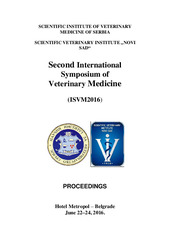| dc.creator | Babić, Milijana | |
| dc.creator | Savić Radovanović, Radoslava | |
| dc.creator | Nikolić, Aleksandra | |
| dc.creator | Stajković, Silvana | |
| dc.date.accessioned | 2023-03-21T13:02:35Z | |
| dc.date.available | 2023-03-21T13:02:35Z | |
| dc.date.issued | 2016 | |
| dc.identifier.isbn | 978-86-81761-55-7 | |
| dc.identifier.uri | https://vet-erinar.vet.bg.ac.rs/handle/123456789/2732 | |
| dc.description.abstract | In the dairy industry temeratures of pasteurisation are applied to destroy pathogen microorganisms and reduce the number of saprophytic microorganisms. Among saprophyte microoganisms there are microorganisms that survive pasteurization temperatures and it can be spore-forming, or non-sporeforming gram-positive bacteria. Heat-resistant microorganisms are defined as microorganisms that survive temperature of law pasterization (at 63‒65oC for 30 minutes). Some mesophilic microorganisms possess heat-resistant spores that survive high heat regimes, and after completed heat treatment there is possibility for spore germination, which than may propagate under conditions of room temperature or in conditions for cheese ripening.
The aim of this study was to determine the ability of heat-resistant microorganisms to grow at storage temperatures for milk and cheese ripening.
Material represented 20 isolates of heat-resistant microorganisms from milk. The isolates of heat-resistant microorganisms from slant were seeded into nutrient broth, which was incubated at 30oC for 24h, and than from prepared serial decimal solutions inoculated 1 ml from corresponding decimal dilution into sterile Petri-dish, which was overflowed with nutrient agar. Inoculated Petri-dishes were incubated at 30oC/72h, than at rooom temeprature (20±2oC/72h), because these are conditions for storage of products such as sterilized milk, whereas temperature of 10oC±1oC/10 days, because it is temperature for storage of pasteurized milk, and temperature for cheese ripening as well. Standard SRPS ISO 4883 was used for the enumeration of microorganisms.
The results showed that 20 isolates growed at 30oC/72h and room temeperature (20±2oC/72h), and there is no deviations between avarage values for number of heat-resistant microorganisms (log10 cfu/mL), but it was observed that interval between minimal and maximal number (log10 cfu/mL) was highrer for isoaltes incubated at room temperature. At temperature for cheese ripening 10oC±1oC, 9 isoaltes of heat-resistant microorganisms did not show growth and remaining 11 isolates growed and the number ranged from 6,32 to 4,10 log10 cfu/mL (x̄=5,26). | sr |
| dc.language.iso | en | sr |
| dc.publisher | Belgrade : Scientific Institute of Veterinary Medicine of Serbia | sr |
| dc.rights | openAccess | sr |
| dc.rights.uri | https://creativecommons.org/licenses/by/4.0/ | |
| dc.source | Second International Symposium of Veterinary Medicine (ISVM2016), Belgrade, June 22-24, 2016 | sr |
| dc.subject | heat-resistant microorganisms | sr |
| dc.subject | growth | sr |
| dc.subject | storage temepartures | sr |
| dc.title | Growth of heat-resistant microorganisms isolated from milk at storage temperatures for dairy products | sr |
| dc.type | conferenceObject | sr |
| dc.rights.license | BY | sr |
| dc.citation.spage | 264 | |
| dc.citation.epage | 264 | |
| dc.description.other | Proceedings | sr |
| dc.identifier.fulltext | http://veterinar.vet.bg.ac.rs/bitstream/id/7996/bitstream_7996.pdf | |
| dc.identifier.rcub | https://hdl.handle.net/21.15107/rcub_veterinar_2732 | |
| dc.type.version | publishedVersion | sr |

